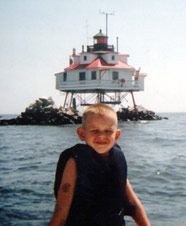 |
|||||
|
Volume 12, Issue 20 ~ May 13-19, 2004
|
|||||
|
|
Lighthouses are Fishermen’s Friends Anythin’ for a quiet life, as the man said when he took the sitivation at the lighthouse.
Whether they be big striped bass or small Norfolk spot, fish look for what fishermen call structure: drop-offs and irregular bottom. Thereabouts, tidal rips and other water movement bring meals to fish. Even the foundation of a lighthouse not infrequently serves that purpose. Lighthouses are the friend of a fisherman, a beacon for catching. In the past several years, 129-year-old Thomas Point Light, the last screw pile-style lighthouse in the nation still shining from its original location, has been one of the most productive sites for catching huge rockfish in the trophy season as well as much of the rest of they year. It’s also been a favored location for bluefish, sea trout, white perch and spot. Boatmen without electronics can easily find those waters, thanks to the distinctive configuration of this picturesque facility. Thus more than a few anglers hail the news that, thanks to an agreement with the National Park Service, good old Thomas Point will remain where and what she is, a beacon for finding fish. She will become a tourist attraction, host probably 5,000 visitors a year. Yet she will be visited by that number several-fold or more in boats rigged to catch fish. A Fishing First for Thomas Point Nearly 40 years ago, Thomas Point Light, then manned by Coast Guardsmen, played a significant role in the origin of a highly regarded technique in Chesapeake fishing: Plug casting for breaking fish. A Massachusetts fisherman, Bob Pond, devised a plug to catch rockfish and blues on the surface where anglers could see the fish strike, then fight atop the water. It’s the most exciting of all angling techniques. New England fishermen had long used surface plugs, but they were unheard of in Chesapeake Bay. That Pond was determined to change. He asked Don Carpenter, then an outdoor writer for the Washington Daily News (and later the Annapolis Capital), and me — then of the Sun papers — to take him to a likely fish-catching spot on the Bay to showcase the effectiveness of his lure. We chose Thomas Point. And boy, did we catch fish. The Coast Guardsmen tending the light as they had done since it was vacated by a lighthouse keeper watched fascinated. This was a method they could use from the stone pile that supports the light, and they called to us for samples. Soon, they were catching fish. Their word-of-mouth testimony shouted to fishermen close to the light probably did more to embellish the popularity of surface fishing for rockfish and blues than all the columns Don and I ever wrote about the sport. So to me, the continued presence of Thomas Point Light where she stood, and still stands, is a historical marker reminding passersby of the introduction of light tackle angling for rockfish in the Chesapeake, in which I played only a minor role. It was the structure that attracted the fish. |
||||
|
© COPYRIGHT 2004 by New Bay Enterprises, Inc. All rights reserved. Last updated May 13, 2004 @ 1:30am. |

